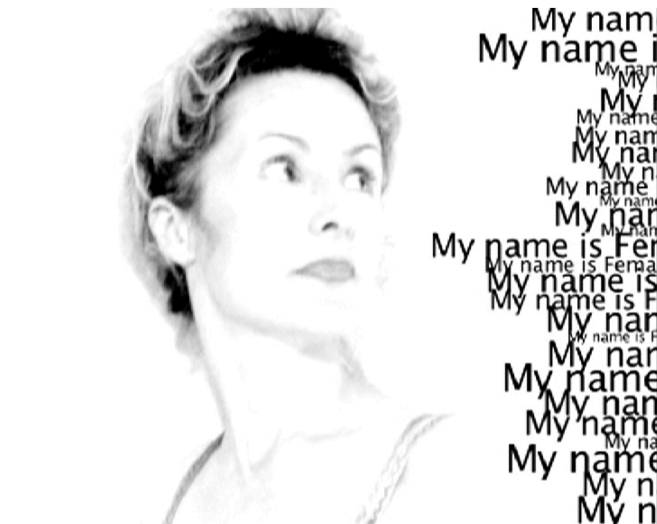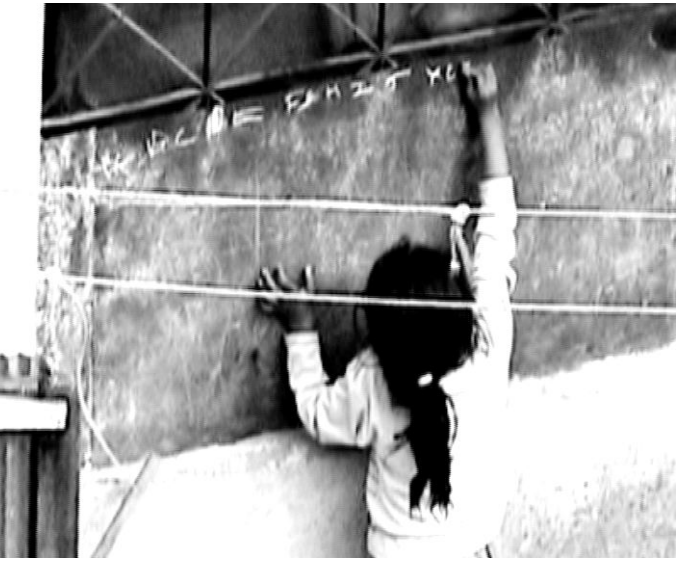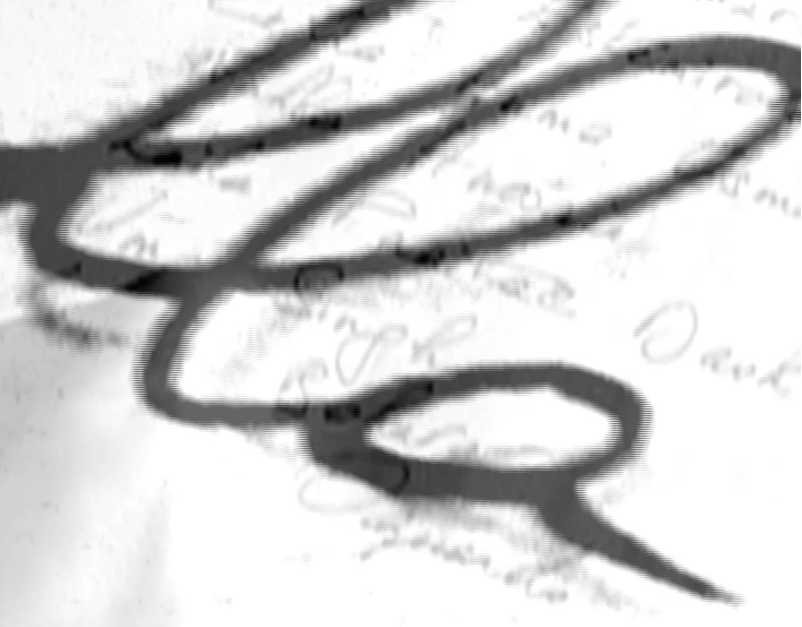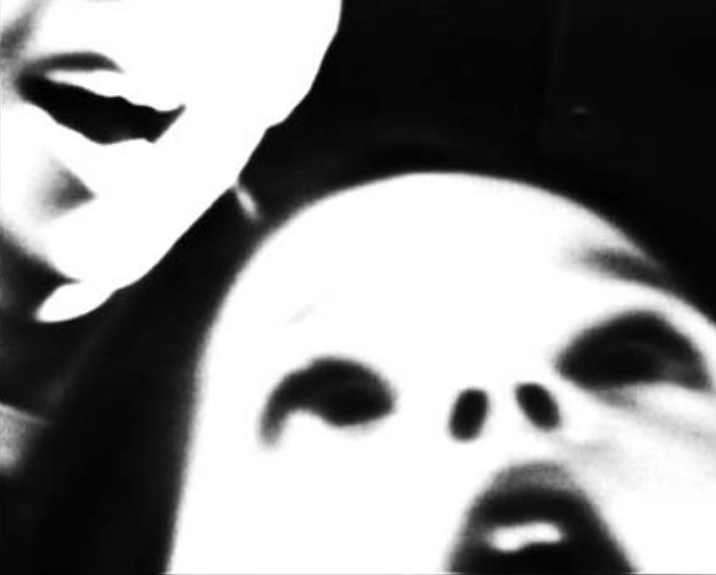Videos by Veronique Sapin
"Vuelvo mi rostro hacia ti". Sonido: Fleurine Guiguet d'Oron. Duración: 5'25". Blanco y Negro Sin palabras, solo música 2014
"I am turning my face towards you". Sound: Fleurine Guiguet d'Oron. Lenght: 5'25". Black and White No word, just music 2014
Véronique Sapin eligió hablar de uno de estos actos que empujan a la humanidad a retroceder hacia el animal: el ataque con ácido. El ataque con ácido es un delito con un marcado sesgo de género. Las mujeres y las niñas son víctimas en el 75-80% de los casos. De las mujeres víctimas, alrededor del 30% son menores de 18 años. Cada año se registran 1.500 casos en todo el mundo. Sin embargo, es probable que eso no se informe masivamente. La mayoría de las víctimas temen denunciarlo a la policía por temor a represalias. el ácido los ataques van en aumento. Mi nombre es Ser Humano. Tengo derecho a elegir todo en mi vida; igual que tú; porque es natural. ¿NO LO ES? Por eso estoy volviendo mi rostro hacia ti con total confianza. Así imaginamos lo que debe ser la forma más alta de las relaciones entre los seres humanos. Todavía estamos lejos de este ideal.
Véronique Sapin chose to speak about one of these acts which drive humanity to regress towards the animal: the acid attack. The acid attack is a crime with a marked gender skew. Women and girls are victims in 75-80% of cases. Of the female victims, about 30% are under 18. 1,500 cases are recorded around the world every year. However that is likely to be massively underreported. Most victims are fearful to report it to the police for fear of reprisal. The acid attacks are increasing. My name is Human Being. I have the right to choose everything in my life; just like you; because it's only natural. ISN' T IT ? That's why I am turning my face towards you with complete confidence. This is the way we imagine what should be the highest shape of the relations between the human beings. We are still far from this ideal.
“Y sin embargo, ella se vuelve”. 4 min 36 seg 2019. 1 videoproyector. Las imágenes se cortan en 3 partes; vemos solo una parte o dos partes juntas.
"And yet she turns." 4 min 36 sec 2019. 1 video projector. Images are cut into 3 parts; we see only one part or two parts together.
"Y Sin embargo, Ella Gira" es una famosa expresión atribuida a Galileo (1564-1642) quien habría pronunciado esta frase justo después de ser obligado por la inquisición católica, a rechazar su teoría, considerada como herética, de que la tierra giraba alrededor del sol. . Esta frase se convirtió en un símbolo del advenimiento científico sobre el oscurantismo religioso. Para Véronique Sapin, es un símbolo de lo que sucederá un día, inevitablemente, en las conciencias y los hechos a través del juego de la simple lógica histórica.
La imagen se divide en tres "Frame" que aparecen en las esquinas o en el centro de la imagen según un ciclo. Cada uno representa un espacio temporal, la metáfora de una conciencia en 3 fases históricas.
- El primer cuadro aparece a la izquierda de la imagen. Vemos un paisaje de un desierto que está tenuemente iluminado por un amanecer (30 seg.)
- El segundo cuadro aparece junto al primero en el centro de la imagen. Una mujer está de pie en el mismo paisaje tratando de avanzar hacia el Marco. El suelo retrocedió bajo sus pies y la trajo de vuelta 3 veces. (1 minuto)
- Y luego, el segundo cuadro desaparece mientras otro se instala a la derecha de la imagen. Una mujer corre, corre, salta. Su salto es detenido por el marco. Ella vuelve y empieza de nuevo. (1 minuto)
- El tercer cuadro desaparece. Todavía vemos el primero con su desierto paisaje en el que se presenta una mujer que corre. Ella está poniendo sus manos en el suelo y haciendo un círculo que la saca del marco (1min).
El sonido crece a saltos.
Ella
ella era, ella es
enmarcado
Para realzarla, se especificó.
El marco es estrecho.
Siempre.
Esto está en la naturaleza de las cosas, se repitió.
Ella lo creía, todavía lo cree, casi siempre.
Casi.
Así que decide intentar creer que podría ser de otra manera.
El paisaje la precede, la impulsa y luego retrocede bajo ella.
pies.
Así que decide creer que debería ser de otra manera.
Ella precede al paisaje, se impulsa, luego choca contra el marco.
Entonces, ella decide que será como debe ser.
Fuera de cuadro.
"And Yet, She Turns" is a famous expression attributed to Galileo (1564-1642) who would have pronounced this sentence just after being forced by the Catholic inquisition, to reject his theory, considered as heretic, that the earth revolved around the sun. This sentence became a symbol of the scientific advent on religious obscurantism. For Véronique Sapin, it is a symbol of what will happen one day, inevitably, in consciences and facts through the play of simple historical logic.
The image is divided into three "Frame" which appear in the corners or
in the centre of the image according to a cycle. Each represents a
temporal space, the metaphor of an awareness in 3 historical phases.
- The first frame appears on the image's left. We see a landscape of a
desert which is dimly illuminated by a sunrise (30 sec.)
- The second frame apperas next to the first in the center of the image. A woman is standing in the same landscape trying to advance to the Frame. Rhe ground receded under her feet and brought her back 3 times. (1 min)
- And then, the second frame disappear while another one settles on the right of the image. A woman is rushing, runing, jumping. Her jump is stopped by the frame. She goes back and starts again. (1 min)
- the third frame disappears. We still see the first one with its desert
landscape in which occurs a woman who is rushing. She is putting her hands on the ground and make a whell that leads her out of the frame (1min).
The sound grows by leaps.
She
She was, she is
framed.
To enhance she, it was specified.
The frame is narrow.
Always.
This is in the nature of things, it was reapeted.
She believed it, still believes it, almost always.
Almost.
So she decides to try to believe that it could be otherwise.
The landscape precedes her, propels her and then retreats under her
feet.
So she decides to believe that it should be otherwise.
She precedes the landscape, propels, thenbumps against the frame.
So, she decides that it will be as it should be.
Out of frame.
“Dead Letters”. 2 min - BW - 2011 / Letras muertas”. 2 min - B/N - 2011
Contenido: Una niña pequeña se divierte escribiendo las letras del abecedario en una pared. dos hombres adultos llegar detrás de ella y pedirle que borre las letras, lo que hace con la punta de los dedos antes partida.
Enunciado: A huis-clos: una niña acorralada frente a una pizarra. Hombres que definen la ley. Un poquito niño aprendiendo su papel futuro. Las otras chicas se han escapado. Si damos a las citas de dos de nuestros grandes hombres de Letras toda la autoridad que Proudhon y Rousseau han ejercido en la Historia del pensamiento, debemos admitir que:
- "Una mujer que ejercita su inteligencia se vuelve fea, loca y guenón" Proudhon
-“Las ciencias, los idiomas y la historia serían para la mujer no sólo inútiles sino dañinas. Ella sólo podrá conocer las artes domésticas y la costura... Su gloria está en la estima de su esposo." Rousseau "Emile”.
Content: A little girl is having fun writing the letters of the alphabet on a wall. Two adult men arrive behind her and ask her to erase the letters, which she does with her fingertips before leaving.
Statement: A huis-clos: a girl cornered in front of a blackboard. Men who define the law. A little boy learning his future role. The other girls have run away.
If we give the quotations of two of our great men of Letters all the authority that Proudhon and Rousseau have exercised in the History of thought, we must admit that:
- "A woman who exercises her intelligence becomes ugly, crazy and a guenon" Proudhon
-"Sciences, languages and history would be to the woman not only useless but harmful. She will only be able to know the domestic arts and needlework... Her glory is in the esteem of her husband." Rousseau "Emile"
Mujeres Borradas. Sonido: Fleurine Guiguet d'Oron. 6 min - B/N - 2012
Erased Women. Sound : Fleurine Guiguet d'Oron. 6 min - BW - 2012
Declaración Tenemos el deber de recordar a las personas que fueron asesinadas por su vinculación a la defensa de los derechos humanos. Este video habla de algunas mujeres que perdieron la vida por ser defensoras de los derechos de las mujeres. Lamentablemente, la lista está incompleta. Este video es un acto de resistencia.
Lista de mujeres mencionadas en el video:
Sitara Achakzai: funcionaria provincial conocida por luchar por los derechos de las mujeres: asesinada en Afganistán, Kandahar, el 13 de abril de 2009
Esperanza Amaris Miranda: miembro de la Organización Femenina Popular (OFP): asesinada en Colombia, el 16 de octubre de 2003
Zilla Huma Usman: Ministra de Bienestar Social en la provincia de Punjab y activista de mujeres que luchan por la emancipación de la mujer: asesinada en Pakistán, 20 de febrero de 2007 Concepción Brizuela: fue fundadora y tesorera de la Unión de Abogados del Pueblo en Mindanao (UPLM). Era una defensora de los derechos humanos de las mujeres: asesinada en Filipinas, 23 de noviembre de 2009
Nahla Hussain: líder de la liga de mujeres del Partido Comunista Kurdo: asesinada en Irak, Bagdad, 18 de diciembre de 2008
Natalia Estemirova: defensora de los derechos humanos: asesinada en Rusia, Chechenia, julio de 2009
Shazia Begum y Shamim Begum: maestras de escuela de niñas: asesinadas en Pakistán, 5 de noviembre de 2009
Laila Paaitae Daoh: activista por los derechos de las mujeres y defensora de la paz. Presuntos insurgentes mataron a su hijo mayor en 2004 y a su esposo y segundo hijo en 2006: asesinado en Tailandia, 12 de marzo de 2009
Aqila al-Hashimi: Obtuvo una licenciatura en derecho en Irak y un doctorado en literatura francesa en la Sorbona. Fue miembro del Consejo de Gobierno iraquí interino. Ella apoyó los derechos de las mujeres: asesinada en Irak, 25 de septiembre de 2003
Uma Singh: 26 años, trabajaba como periodista para el Janakpur Today Daily y "Radio Today FM" y era miembro de la Red de Defensoras de los Derechos Humanos de las Mujeres: asesinada en Nepal el 11 de enero de 2009
Laxmi Bohara: defensora de los derechos humanos: asesinada en Nepal, junio de 2008
Cynthia Oquendo: joven madre artística, también fue defensora de derechos humanos, abogada y miembro de la UPLM: asesinada en Filipinas, 23 de noviembre de 2009
Zeena al-Qushtaini: era propietaria de una de las farmacias más conocidas de Bagdad y se relacionaba con mujeres activistas: asesinada en Irak el 5 de marzo de 2005
Safia Amajan: defensora de los derechos de las mujeres en Afganistán durante décadas. Se desempeñó como jefa del departamento de mujeres en el gobierno de la ciudad de Kandahar: asesinada en Afganistán, 25 de septiembre de 2006
Yolanda Izquierdo: activista por los derechos de las mujeres: asesinada en Colombia, 31 de enero de 2007 Amal al-Ma’amalachi: activista por los derechos de las mujeres y asesora del gobierno: asesinada en Irak, noviembre de 2009
Ana Isabel Gómez: defensora de derechos humanos: asesinada en Colombia, 14 de abril de 2009
Malalai Kakar: fue la mujer policía más destacada de Afganistán y se desempeñó como jefa del departamento de delitos contra la mujer de Kandahar. Fue la primera mujer en asistir y graduarse de la Academia de Policía de Kandahar: asesinada en Afganistán, el 28 de septiembre de 2008.
Desafortunadamente, esta lista está lejos de ser completa
Statement We have a duty of remembrance towards the persons who were murdered because of their involvement to the human rights defense. This video speaks about some women who lost their life because they were women's rights defenders. The list is unfortunatly incomplete. This video is an act of resistance.
List of mentioned women in the video:
Sitara Achakzai : provincial official known for fighting for women's rights : murdered in Afghanistan, Kandahar, April 13th 2009
Esperanza Amaris Miranda: member of the Organización Femenina Popular (OFP) : murdered in Colombia, October 16th 2003
Zilla Huma Usman : Minister for Social Welfare in Punjab province and women’s activist campaigning for emancipation of women: murdered in Pakistan, February 20th 2007 Concepcion Brizuela : she was a founder and treasurer of the Union of People’s Lawyers in Mindanao (UPLM). She was a women’s human rights defender: murdered in Philippines, November 23, 2009
Nahla Hussain: the leader of the women's league of the Kurdish Communist Party: murdered in Iraq, Baghdad, December 18, 2008
Natalia Estemirova: human rights defender: murdered in Russia, Chechnya, Jully 2009
Shazia Begum and Shamim Begum: teachers for girl’s school: murdered in Pakistan, November 5 2009
Laila Paaitae Daoh : women's rights activist and peace advocate. Alleged insurgents killed her eldest son in 2004 and her husband and second son in 2006: murdered in Thailand, March 12, 2009
Aqila al-Hashimi: She gained a degree in law in Iraq and a doctorate in French Literature at the Sorbonne. She was a member of the interim Iraqi Governing Council. She supported women’s rights: murdered in Iraq, September 25, 2003
Uma Singh: 26, worked as a journalist for the Janakpur Today Daily and "Radio Today FM" and was a member of the Women's Human Rights Defender Network: murdered in Nepal, 11 January 2009
Laxmi Bohara: human rights defender: murdered in Nepal, June 2008
Cynthia Oquendo: a young artistic mother, was also a human rights defender, lawyer and member of UPLM: murdered in Philippines, November 23, 2009
Zeena al-Qushtaini: owned one of Baghdad’s best-known pharmacies and mingled with women activists: murdered in Iraq, March 05, 2005
Safia Amajan: women's rights defender in Afghanistan for decades. She served as the head of the women's department in Kandahar's city government: murdered in Afghanistan, September 25, 2006
Yolanda Izquierdo: women's rights activist: murdered in Colombie, January 31th 2007 Amal al-Ma’amalachi: women’s rights activist and government adviser: murdered in Iraq, November 2009
Ana Isabel Gomez: human rights defender: murdered in Colombie, April 14 2009
Malalai Kakar: she was Afghanistan's most prominent policewoman, serving as the head of Kandahar's department for crimes against women. She was the first woman to attend and graduate from the Kandahar Police Academy: murdered in Afghanistan, September 28 2008
Unfortunately, this list is far from complete.
MUJER versus MUJER. 2 min - B/N - sonido - 2015 / WOMAN versus WOMEN. 2 min - BW - sound - 2015
Las adolescentes y las mujeres jóvenes todavía se ven obligadas a casarse con un hombre que ni eligen ni conocen.
La primera parte del video muestra a una novia balanceándose sobre un cable, reflejando su futuro incierto. Es su Crossing Over personal. Su caída es el símbolo de todas estas mujeres casadas que entran en esta vida de sometimiento y abusos.
La segunda parte del video examina las protestas de estas mujeres contra la violencia y su lucha por sus derechos. El Conservador rechaza sus afirmaciones como una teoría occidental cuyas pretensiones universalistas reflejan un prejuicio etnocéntrico.
En nuestras propias sociedades, vimos que las acciones contra la dignidad de la mujer y su libertad se hacían aceptables ante los tribunales occidentales: los jueces legos no se atrevieron a condenar estas prácticas bárbaras contra las mujeres debido a una comprensión sesgada del concepto de multiculturalismo. De la hija de un hombre a la esposa de otro, la posición subordinada e inferior de la mujer va en contra de todas nuestras leyes.
Incluso en Francia, la patria de los derechos humanos, hablamos de "Derechos del Hombre". La Revolución Francesa no incluyó a las mujeres en los Derechos Humanos, por eso todavía hoy hablamos de Derechos del Hombre (generalmente con "h" minúscula).
Teenagers and young women are still constrained to marry a man they neither choose, nor even met.
The first part of the video shows a bride on balancing on a wire, reflecting her uncertain future. It's her personal Crossing Over. Her fall is the symbol of all these married women that enter into this life of submission and abuses.
The second part of the video examines the protests of these women against violence, and their struggle for their rights. The Conservative rejects their claims as a Western theory whose Universalist pretentions reflects an ethnocentric prejudice.
In our own societies, we saw actions against the dignity of women and their liberty becoming acceptable in front of the occidental courts: lay judges did not dare to condemn these barbarians’ practices against women because of a biased understanding of the concept of multiculturalism. From the daughter of a men to the spouse of another, the subordinate and inferior position of women goes against all our laws.
Even in France, the home of human rights, we talk about "Man Rights". The French Revolution did not include women in the Human Rights, that's why we still talk about Man-Rights today (usually with a lower case "h".
FILOSOFIA DE LA PALABRA / PHILOSOPHY OF THE WORD
"El bien, decía Aristóteles en el Libro I de la Ética Nicomaquea, es aquello hacia lo que todo tiende. En el vídeo "Filosofía de la palabra", Véronique Sapin juega con este verbo "tender" utilizándolo en su dimensión concreta y física: en la imagen, se trata de estirar una cuerda. Cuando se estira, la cuerda simboliza el equilibrio, lo correcto, lo bueno. Apretado, como la cuerda de un arco o la de un instrumento musical para tocar justo, puede ayudar a conservar o conquistar el bien. Para seguir estando tensa, la cuerda del vídeo necesita el esfuerzo continuo de cada persona. En la imagen, las mujeres sostienen y controlan la cuerda. Todos tienen un papel que desempeñar para mantenerlo tenso. El vídeo es una metáfora de la necesaria lucha constante contra los ataques a la integridad física y los derechos de las mujeres.
Véronique Sapin metaforiza así lo que Hannah Arendt llama "actuar juntos": actuar es una responsabilidad, lo contrario de la resignación: decir no, negarse, ser capaz de indignarse...
La sucesión de verbos de acción que martillean la imagen del vídeo se hace eco de la reflexión del filósofo de que la acción y el discurso están estrechamente vinculados. El vídeo expone el hecho de que la reunión de personas da lugar al poder político que "surge entre los seres humanos cuando actúan juntos, y retrocede cuando se dispersan".
"The good, said Aristotle in Book I of the Nicomachean Ethics, is that towards which everything tends. In the video "Philosophy of the word", Véronique Sapin plays with this verb "tend" using it in its concrete and physical dimension: in the image, it is a question of stretching a string. When stretched, the string symbolizes balance, what is right, what is good. Tightened, like the string of a bow or that of a musical instrument to play fair, it can help preserve or conquer good. To remain taut, the rope in the video needs the continuous effort of each person. In the image, women hold and control the rope. Everyone has a role to play in keeping it taut. The video is a metaphor for the necessary constant struggle against attacks on the physical integrity and rights of women.
Véronique Sapin thus metaphorizes what Hannah Arendt calls "acting together": acting is a responsibility, the opposite of resignation: saying no, refusing, being capable of being indignant...
The succession of action verbs that hammer the video image echoes the philosopher's reflection that action and discourse are closely linked. The video exposes the fact that the gathering of people gives rise to political power that "arises among human beings when they act together, and recedes when they disperse."
Igualdad, 3 min 30 - BW - sonido / Equality, 3 min 30 - BW - sound
La igualdad es un principio por el cual los seres humanos comparten los mismos derechos y deberes. En el video, dos niños están jugando. Se están retorciendo unos a otros. Grandes sonrisas florecen en sus rostros, pero si miramos detenidamente los gestos del chico, el juego no es tan inocente. Estas imágenes fueron tomadas inesperadamente sin ninguna instrucción.
Equality is a principle whereby human beings share the same rights and duties. In the video, two children are playing. They are twisting each other. Great smiles are flourishing on their faces, but if we look carefully at the boy's gestures, the game is not so innocent. These images was taken unexpectedly without any instructions.
"El grito", 2'34 min / BW and colour / Sound / 2021 "The Scream", 2'34 min / BW and color / Sound / 2021
Este vídeo forma parte de la videocomposición DANGER del colectivo FL'Art (FemLink-Art) El vídeo se incluye con 12 fotografías en B/N y un vídeo. Las fotografías provienen de mi serie "El Grito".
La ciencia ha demostrado que cuando una persona pierde una capacidad sensorial, los otros sentidos pueden compensar agudizándose. En la imagen, la nariz y los ojos están ausentes de las caras. Así, el vacío, la ausencia inquietante, proporciona una presencia adicional para la boca.
El sonido que brota es más potente. En otras palabras, el sonido llega a existir a través del vacío. Estoy buscando un sonido. Un sonido que podría representar a la Humanidad. Cada boca lanza el mismo grito como un coro frente a la condición humana.
En esta serie de fotos con un tema subyacente de violencia, las fotografías no hablan de la agonía, la confusión, la ansiedad, el horror... por lo tanto, son bastante diferentes de la pintura de Munch, cuyo título tomé prestado para esta serie. Los personajes no están aterrorizados. Son personajes rebeldes, comprometidos, militantes, beligerantes. Varias bocas lanzan un mismo grito: el grito de todos los tiempos y de todos los lugares. No hay ojos, narices o bocas aislados en las caras. Eso les permite compartir una sola alma, el alma de la humanidad. Es como el aria de una ópera: el cantante canta el aria después del recitativo cuando la historia está llegando a un punto sin retorno que sólo el aria puede llevar adelante.
This video is part of the DANGER video-composition from the FL'Art (FemLink-Art) collective The video is including with 12 photographies in BW and a video. The photographies come from my series "The Scream".
Science has shown that when a person loses one sensory capacity, the other senses can compensate by becoming more acute. On the picture, the nose and eyes are absent from faces. Thus, the vacuum, the disturbing absence, provides an additional presence for the mouth.
The sound which pours out is more powerful. In other words, the sound comes into existence through the vacuum. I am looking for one sound. One sound which could represent Humanity. Each mouth shouts the same scream as a chorus in the face of the human condition.
In this series of photos with an underlying theme of violence, the photographs don't speak about agony, confusion, anxiety, horror... thus are quite different from the painting by Munch, whose title I borrowed for this series. The characters are not terrorized. They are rebelious, committed, militant, belligerent characters. Several mouths are voicing the same scream: the scream of all times and of all the places. No eyes, noses or mouths are isolated on the faces. That makes it possible for them to share a single soul, the soul of humanity. That's as the aria in an Opera: the singer sings the aria after the recitative when the story is reaching a point of no return which only the aria can take forward.
http://www.veronique-sapin.com
https://artfacts.net/artist/veronique-sapin/341566








